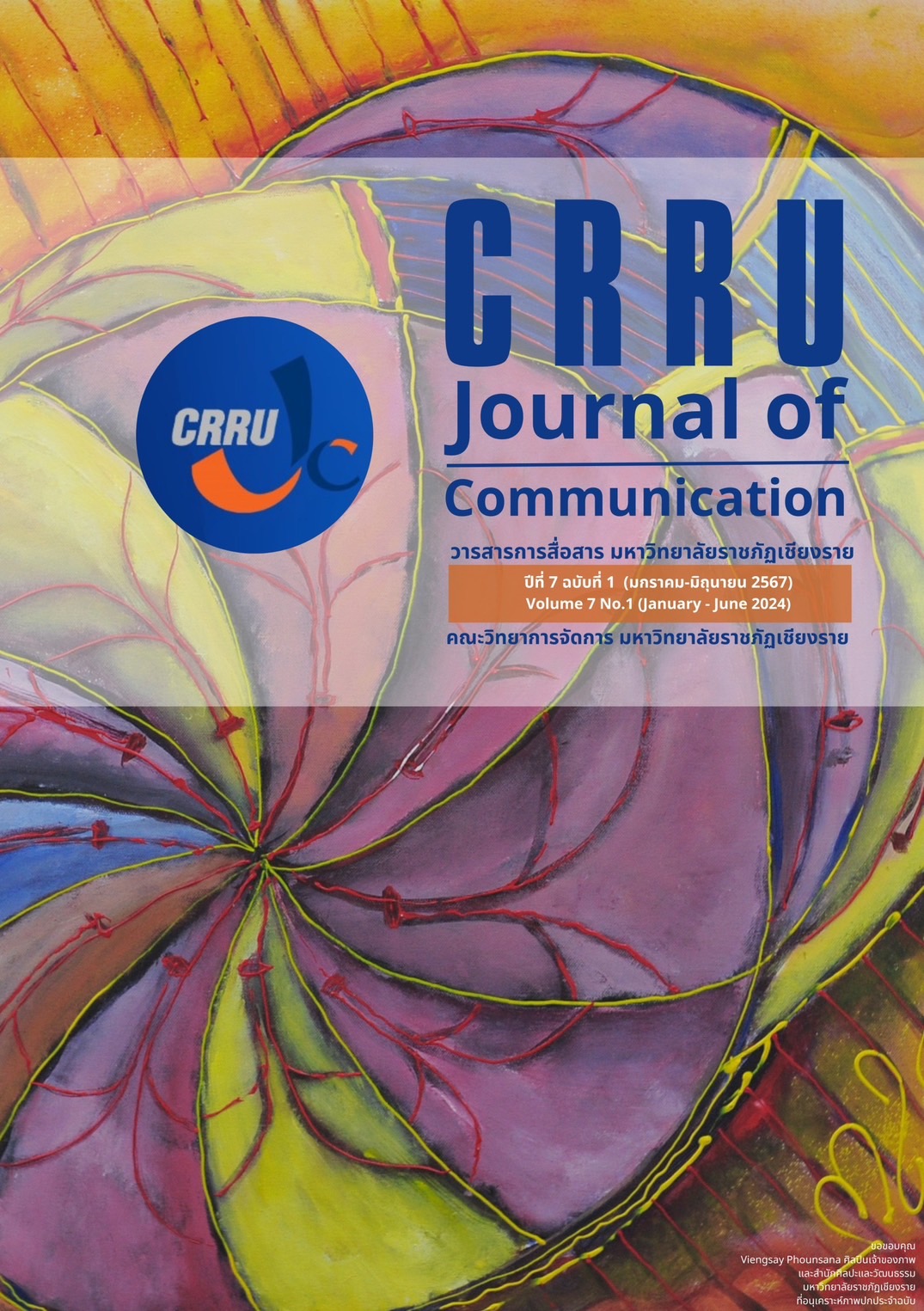Naïve Art Communication Guideline to Enhance Meditation of The Person Preparing to be Quality Elders
Main Article Content
Abstract
The objectives of this qualitative research were: 1. to create a Naïve art communication guideline to enhance meditation of the person preparing to be quality elders, and 2. to create a handbook for enhancing meditation through the practice of a Naïve art. The researcher used document analysis methods. There were 6 key informants involved in Naïve art activity and in-depth interview. Including using the I FLOW headband brain wave measuring device that processes meaning together with the IFLOW S application with 6 other key informants while doing an activity to prove increased meditation when doing a Naïve art activity. As for the activity handbook, has developed from a Naïve art activity and a sample activity handbook was drafted. Then brainstorm with stakeholders of the person preparing to be quality elders, 7 people to find appropriate formats and content. Then take the activity handbook to an open forum to listen to opinions from stakeholders of the person preparing to be quality elders, 60 people to summarize the activity handbook. Also, bringing the complete activity handbook to activities with the person preparing to be quality elders and elders to iterate information. Including publishing in various forms through social media and printed media. The research results found that a Naïve art communication guideline to enhance meditation of the person preparing to be quality elders requires action that must consider communication elements, including the sender, message, channel (activity media, personal media), receiver, and other factors from stakeholders that facilitate the success of a Naïve art to enhance meditation of the person preparing to be quality elders. A Naïve art activity helps to enhance meditation at the khanika samadhi level or momentary concentration. The activity handbook, it should contain a format and content that is appropriate for the main target group, that is, the person preparing to be quality elders. The activity handbook should have the general structure of the book. It is not too informal in appearance, A4 size, uses a font of letter that has looped, easy-to-read, big size, and uses Arabic numerals. As for the content, there must not be much message content (no more than 25 pages). Illustrations are used, emphasizing photographs taken during a Naïve art activity and photographs of a Naïve art work. Including the proposal to use orange as the main color. The activity handbook, it can also be applied to other target groups, such as ADHD children, other vulnerable groups or target groups that are difficult to control.
Article Details
References
กรมสุขภาพจิต กระทรวงสาธารณสุข. (2563). 93 วันสู่สังคม"คนชรา" 5 จังหวัด? คนแก่เยอะสุด-น้อยสุด. สืบค้นจาก dmh.go.th/news-dmh/view.asp?id=30453
กิติมา สุรสนธิ, ศุภกิจ แดงขาว และ อนงค์ลักษณ์ สมแพง. (2557). ความรู้ทางการสื่อสาร (Introduction to Communication) ฉบับปรับปรุงใหม่. กรุงเทพฯ: คณะวารสารศาสตร์และสื่อสารมวลชน มหาวิทยาลัยธรรมศาสตร์.
คมสัน รัตนะสิมากูล. (2562). การสื่อสารแนวคิดวิถีพุทธของมหาวิชชาลัยพุทธเศรษฐศาสตร์. วารสารวิชาการมนุษยศาสตร์และสังคมศาสตร์ มหาวิทยาลัยบูรพา, 27(53), 1-22.
เจ้าฟ้าจุฬาภรวลัยลักษณ์ อัครราชกุมารี กรมพระศรีสวางควัฒน วรขัตติยราชนารี, สมเด็จพระเจ้าน้องนางเธอ. (2562). การศึกษาเพื่อสร้างสรรค์ “หลากลาย หลายชีวิต”. วารสารศิลป์ พีระศรี, 7(2), 24-44.
ชญาณี ฉลาดธัญญกิจ. (2563). การสื่อสารกับผู้อยู่ในกลุ่มอาการภาวะออทิซึมผ่านกระบวนการทอผ้าประยุกต์. วารสารนิเทศสยามปริทัศน์, 20(1), 157-169.
ทัศนีย์ เจนวิถีสุข. (2557). การสื่อสารเพื่อบริหารจัดการอารมณ์ตามแนวทางพระพุทธศาสนา. วารสารครุศาสตร์ปริทรรศน์ฯ, 1(1), 14-26.
นพเกล้า ศรีมาตย์กุล, พิษณุ ศุภนิมิตร และ ชัยยศ อิษฎ์วรพันธุ์. (2562). เซน : สมาธิกับการสร้างสรรค์ศิลปะ. วารสารวิชาการ Veridian E –Journal, Silpakorn University ฉบับภาษาไทย สาขามนุษยศาสตร์ สังคมศาสตร์ และศิลปะ, 12(5), 559-577.
ประติมา ธันยบูรณ์ตระกูล. (2560). การสร้างสรรค์งานศิลปะโดยได้รับแรงบันดาลใจจากศิลปะดั้งเดิม. วารสารวิชาการ Veridian E –Journal, Silpakorn University ฉบับภาษาไทย สาขามนุษยศาสตร์ สังคมศาสตร์ และศิลปะ, 10(2), 2940-2956.
พระพรหมคุณาภรณ์ (ป.อ.ปยุตฺโต). (2552). พุทธธรรม (พิมพ์ครั้งที่ 15). กรุงเทพฯ: บริษัท สหธรรมิก จำกัด.
พระเรืองเดช โชติธมฺโม (เสียงเพราะ), พระครูภาวนาโพธิคุณ, พระมหามงคลกานต์ ฐิตธมฺโม และ โสวิทย์ บำรุงภักดิ์. (2560). วิเคราะห์หลักไตรลักษณ์ในเชิงสุนทรียศาสตร์. วารสารภาษา ศาสนา และวัฒนธรรม, 6(1), 118-130.
เมตตา สุวรรณศร. (2564). จิตรกรรมสื่อผสมการปะติดผ้าด้วยเทคนิค Appliqué ปักด้วยมือที่ได้รับแรงบันดาลใจมาจากผลงานวาดภาพโดยเด็กออทิสติก. วารสารศิลป์ พีระศรี, 9(1), 61-88.
วัชราภรณ์ เรืองสิทธิ์, จำลอง วงษ์ประเสริฐ และ กุลธิดา กุลประฑีปัญญา. (2561). กระบวนการจัดกิจกรรมที่เกี่ยวข้องกับพฤติกรรมการดูแลสุขภาพผู้สูงอายุไทย: การทบทวนวรรณกรรมอย่างเป็นระบบ. วารสารพยาบาลกระทรวงสาธารณสุข, 28(3), 131-144.
สกนธ์ ภู่งามดี. (2563). อะไรคือศิลปะแบบนาอีฟ (Naive Art). สืบค้นจาก https://intrend.trueid.net/article/อะไรคือศิลปะแบบนาอีฟ-naive-art- trueidintrend_52226
สายอักษร รักคง. (2563). การเยียวยาสภาวะทางจิตด้วยศิลปะบำบัด. วารสารศิลป์ พีระศรี, 7(2), 65-84.
สำนักงานสถิติแห่งชาติ. (ม.ป.ป.). จำนวนประชากรจากการทะเบียน จำแนกตามกลุ่มอายุ ภาคและจังหวัด พ.ศ. 2555 – 2564. สืบค้นจาก statbbi.nso.go.th/staticreport/page/sector/th/01.aspx
สิรินภา อิ่มศิริ. (2559). สู่วัยชราอย่างสุขใจ-สูงวัยอย่างมีคุณภาพ ต้องเริ่มตั้งแต่อายุ 45. สืบค้นจาก www.thaipbs.or.th/news/content/256279
สุริยะ ฉายะเจริญ, สุชาติ เถาทอง และ ภานุ สรวยสุวรรณ. (2564). การสร้างสรรค์การดำเนินงานและการสื่อสารในกิจกรรมศิลปะเชิงสัมพันธ์การวาดเส้นสมาธิ. วารสารนิเทศสยามปริทัศน์, 20(1), 70-87.
อรทยา สารมาศ, ปุณณรัตน์ พิชญไพบูลย์ และ โสมฉาย บุญญานันต์. (2562). การใช้ศิลปะเป็นฐานเพื่อพัฒนาสุขภาวะของผู้สูงอายุ: การทบทวนวรรณกรรมอย่างเป็นระบบ. วารสารวิชาการเครือข่ายบัณฑิตศึกษามหาวิทยาลัยราชภัฏภาคเหนือ, 9(2), 17-32.
Brodskaïa, N. (2012). Naive art. New York: Parkstone International.
Chaisitthisak, T., & Phaosavasdi, K. (2018). Drawing: A dialogue with the present and objects without additives. Humanities, Arts and Social Sciences Studies, 18(1), 57-73.
Gambis, M. (2015). Why making art is the new meditation. Retrieved from www.washingtonpost.com/news/inspired-life/wp/2015/08/25/why-making-art-is-the-new-meditation/
Hutchins, J. (2020). Art as meditation. Retrieved from www.unity.org/article/art-meditation
Wolfe, A. (2021). Meditation and art: examples and how this practice helps you creatively. Retrieved from www.skillshare.com/blog/meditation-and-art-examples-and-how-this-practice-helps-you-creatively/
Zenart. (2022). 21 days of art meditation. Retrieved from www.zenart.info/art-meditation

